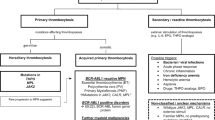Abstract
Objective
To comparatively study the expressive conditions of platelet activation related factors (GP I b, GP II b- III a and GMP-140) in healthy subjects and patients with coronary heart disease (CHD) of blood-stasis (BS) or non-blood-stasis (non-BS) syndrome, and to analyze the relationship between the activities of various glycoproteins and the polymorphism of genes.
Methods
With case control design adopted, patients with the CHD (40 of BS, 37 of non-BS) and 39 healthy subjects for control, all fitting to the inclusion criteria, were selected in this study. The number of affected coronary branches was recorded by the contrast examination. The mean fluorescence intensity (MFI) of GP I b, GP II b- III a, and GMP-140 (CD42b, CD61, CD62p) in patients and healthy persons was measured with flow cytometry, the polymorphism of HPA-3 gene was detected by Taqman probe technique and that of HPA-2 gene was determined by gene sequencing.
Results
MFI of CD61 and CD62p was higher in the CHD patients than in the healthy control, which was also higher in patients of BS syndrome than in patients of non-BS syndrome (P<0.05); MFI of CD42b was lower in the CHD patients than in the healthy control (P<0.05), but showing insignificant difference between BS and non-BS syndrome (P>0.05); at the same time, no significant difference of all the above-mentioned three MFI could be found in patients with various numbers of affected coronary branches, neither in patients with different genotypes at GP II b HPA-3 and GP I b HPA-2 polymorphism loci (P>0.05).
Conclusion
(1) The activities of GP II b- III a and GMP-140 were obviously increased in the genesis and developing process of CHD and CHD of BS syndrome, and so they could be taken as one of the objective indexes for microscopic diagnosis of BS syndrome. (2) The level of GP I b was lower in CHD patients than in healthy persons, but it was not a sensitive indicator for BS syndrome of CHD. (3) Levels of GP II b- III a, GP I b and GMP-140 were not related with the number of affected coronary branches in CHD patients. (4) The changes in amino-acids expression induced by the two loci brought no significant influence on GP I b and GP II b- III a activities.
Similar content being viewed by others
References
Chen HZ, ed. Practical internal medicine. 12th ed. Beijing: People’s Medical Publishing House, 2005:1472–1473.
Society of Cardiology, Chinese Association of the Integration of Traditional and Western Medicine. The diagnostic criteria of TCM in coronary heart disease. Chin J Integr Tradit West Med (Chin) 1991;11(5):257.
Jackson SP, Schoenwaelder SM. Antiplatelet therapy: in search of the ‘magic bullet’. Nat Rev Drug Discov 2003;2:775–789.
Rauch U, Osende JI, Fuster V, et al. Thrombus formation on atherosclerotic plaques: pathogenesis and clinical consequences. Ann Intern Med 2001; 134: 224–238.
Michelson AD, Barnard MR, Krueger LA, et al. Circulating monocyte-platelet aggregates are a more sensitive marker of in vivo platelet activation than platelet surface P-selectin: studies in baboons, human coronary intervention, and human acute myocardial infarction. Circulation 2001;104: 1533–1537.
Zhang WG, Yan TX, Gao FJ, et al. Study on Effect of Zhixinkang Capsule (脂欣康胶囊) in treating unstable effort angina and hyperlipidemia and its function in vascular endothelium protection. Chin J Integr Med 2003;9(1): 25–30.
Liu ZG, Yu XY. Effects of Xuezhikang Capsule (血脂康胶囊) on blood lipids, platelet activation and coagulationfibrinolysis activity in patients with hyperlipidemia. Chin J Integr Med 2004;10(4):259–262.
Wang JZ, ed. Applications of flow cytometry in clinical researches. 1st ed. Shanghai: Shanghai Science and Technology Press, 2005: 237.
Tian XY, Liu ZZ, Zhang JL. Relationship between different coronary lesions of unstable angina pectoris and platelet GP II b- III a receptor expression. J Cardiovasc Pulmonary Dis (Chin) 2002;21(1):22–23.
Williams Ms, Ng’alla LS, Vaidya D, et al. Platelet functional implications of glycoprotein I balpha polymorphisms in African Americans. Am J Hematol 2007; 82:15–22.
Author information
Authors and Affiliations
Corresponding author
Additional information
Supported by the Major Program Project of National Natural Science Foundation of China (No. 90409021)
Rights and permissions
About this article
Cite this article
Xue, M., Chen, Kj. & Yin, Hj. Relationship between platelet activation related factors and polymorphism of related genes in patients with coronary heart disease of blood-stasis syndrome. Chin. J. Integr. Med. 14, 267–273 (2008). https://doi.org/10.1007/s11655-008-0267-1
Received:
Published:
Issue Date:
DOI: https://doi.org/10.1007/s11655-008-0267-1




